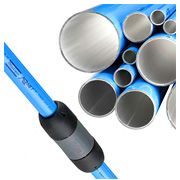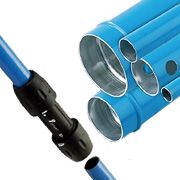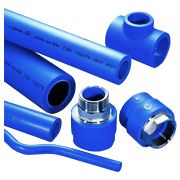Pneumatic installations
The compressed air network is a very important component of the entire work system in production or service plants. Compressed air is used as a drive for pneumatic devices and tools. Together with the electrical network, the pneumatic system is an irreplaceable source of drive that is used in almost all devices. Therefore, a very important aspect is which pipes, of what diameter and in what configuration we use in the compressed air network.
Very often in many production companies it happens that the replacement or modernization of the compressed air installation allows to reduce the power consumption of compressors or excludes the purchase of a new compressor with greater power. This is especially true of a very ineffective pneumatic installation made of black steel pipes, which is affected by corrosion, contamination, high pressure drop due to fouling and leakage due to corrosion. Modernization of the compressed air installation is carried out through the optimal selection of the diameter of the compressed air installation and its configuration as well as the removal of all leaks related to the operation of the old compressed air installation (especially black pipes, not galvanized inside).
It turns out then that the compressor used in the plant is of sufficient power or begins to use less electricity for the production of compressed air, which we lose through leaks in the compressed air system, overcoming pressure resistance due to the insufficient diameter of installation pipes or their internal corrosion.
Our company offers compressed air pneumatic installations made of aluminum pipes from 17 to 158 mm. polypropylene from 20 to 90 mm. and from stainless steel pipes 304L from 15 to 108mm or 316L from 15 to 42mm. The aluminum installation systems we offer are AirNet Atlas Copco and TransAir Legris Parker . Pneumatic installations made of polypropylene are the Coprax PN20 system.
AirNet pneumatic installations
Aluminum pipe installation systems are the simplest compressed air installation systems that do not require many specialized or expensive tools for installation, a pipe cutter and deburrer is enough to connect the pipe with the coupling. In the TransAir system for diameters above 40 mm. additional tools are required for making holes in pipes or for making clamping rings (these tools can be borrowed from our company). For stainless steel piping systems, a crimp tool for connectors and pipes is required. In polypropylene pipe systems, a welding machine is required to make the joints join the pipes.
The cheapest system is the Coprax PN20 polypropylene pipe system and it is justified when we build pneumatic compressed air installations for small flows and from pipes with small diameters, eg DN 20 to DN 32. Pipes in this system are 4 m long. It should always be noted that PN20 polypropylene pipes have quite a thick wall and, for example, a DN 25 pipe has an internal diameter of only 16.6 mm - which is the same as an aluminum pipe with a diameter of DN 17. Therefore, with larger diameters of polypropylene PN20 pipes, e.g. DN 63 , 75 or 90, it is worth considering a system of aluminum pipes, the diameter of which is correspondingly smaller, they are lighter, easier to assemble and the investment cost itself begins to be comparable. Moreover, the welded system cannot be dismantled, i.e. the connection between the pipe and the coupler once made cannot be reused.
Pneumatic installation made of aluminum pipes
In our opinion, the best system for performing a compressed air installation is the AirNet Atlas Copco or TransAir Legris aluminum pipe system. They are characterized primarily by a very easy and quick method of assembly as well as low weight of materials (which is very important for larger pipe diameters in the planning of support places or the arrangement of handles). In addition, AirNet Atlas Copco and TransAir Legris pneumatic installations have appropriate certificates allowing them to be used in the construction of compressed air installations. Pipes in this system are delivered in 3 m or 6 m lengths in the TransAir Legris system and, respectively, in 2.85 m and 5.7 m in the Atlas Copco AirNet system. The full range of connectors available in these systems is presented on our website.
The cost of installation materials in aluminum piping systems for compressed air is higher than polypropylene pipes, but it should be remembered that aluminum pipes have a smaller wall, which means that e.g. a PN20 polypropylene pipe with a diameter of DN 90 can be successfully replaced with an aluminum pipe DN 63. In addition, with larger pipeline diameters up to compressed air, the time needed to install compressed air in an aluminum pipe system is several times shorter. Another, perhaps the most important advantage of a compressed air installation made of aluminum pipes is the possibility of disassembling it and reusing the joint and pipes when building the installation elsewhere or changing its configuration.
Installation of 304L or 316L stainless steel pipes is available on direct customer request.
Offer pneumatic installations
We encourage you to submit inquiries regarding the execution, selection of diameters or shape of the compressed air installation. A properly designed and constructed compressed air installation will ensure a low pressure drop in the installation, fast compressed air flow, no leaks, no corrosion and will allow for optimal use of compressors in the production of compressed air and its transmission to receivers.



